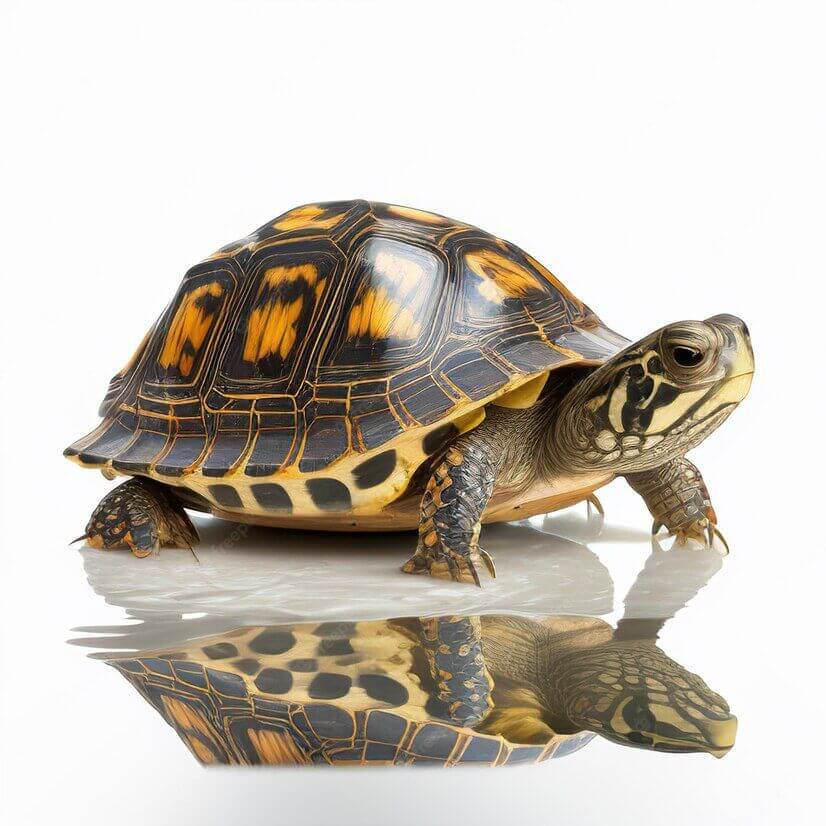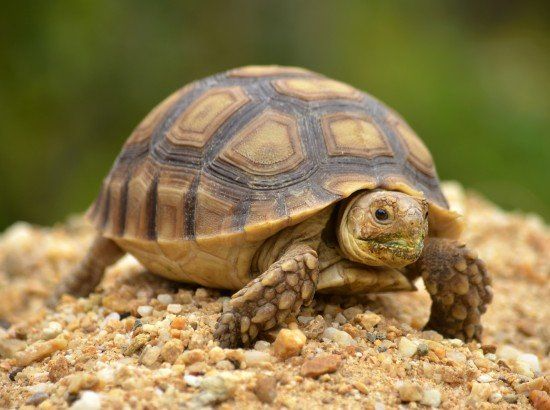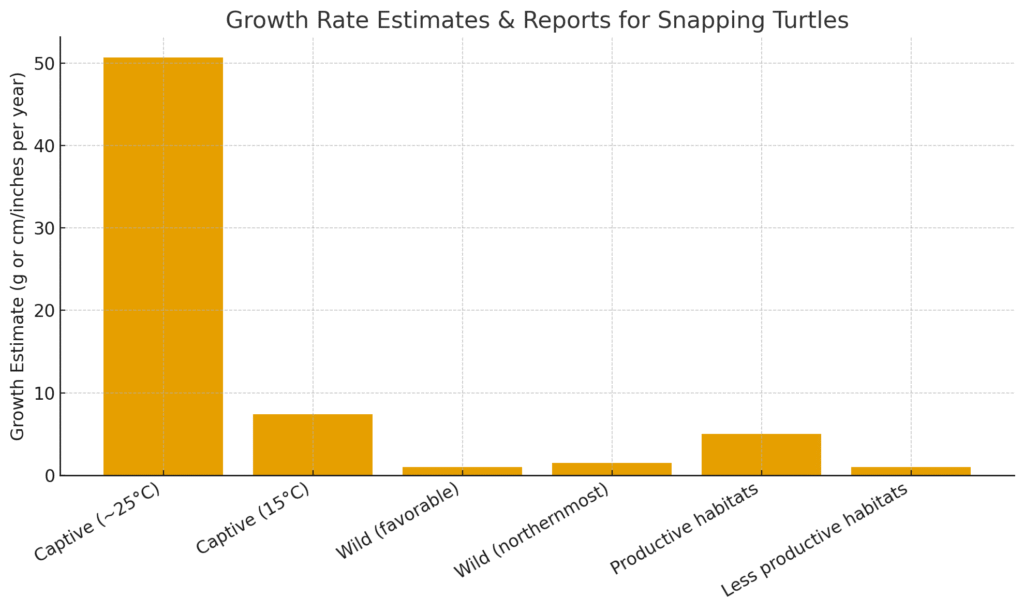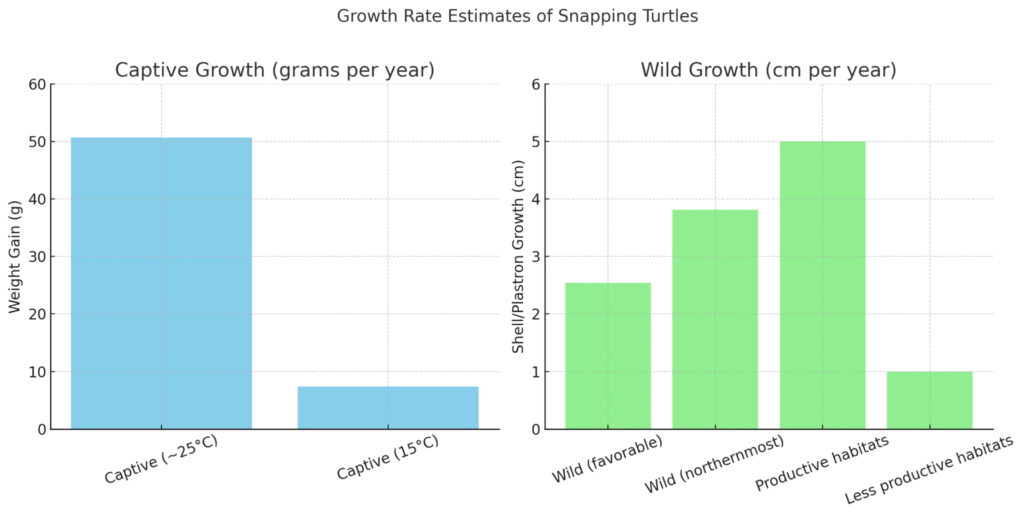Introduction How Fast Do Snapping Turtles Grow

When people first encounter hatchlings, they often assume that their growth rates remain uniform across all populations, yet the story is much more complex. In my own observations, I have seen juveniles in productive habitats develop faster during summer months like June, July, and August, when the active feeding season spans nearly 145 days. Under controlled studies at ~25 °C, young turtles weighing ~7.4 g could reach ~50.7 g in just one year, which contrasts sharply with results in colder 15 °C conditions where growth is barely noticeable. This contrast illustrates how climate, latitude, and region impose constraints on whether a turtle reaches an adult carapace size of 20–36 cm or weighs anywhere between 4.5 and 16.0 kg.
Looking at long-term changes, males and females show a distinct divergence after the first decade. Males often achieve faster growth in productive habitats, which leads to higher reproductive output. In contrast, individuals in less productive habitats display slow growth.
I’ve measured hatchling growth of just 1 cm per year in places like Iowa. Other Ontario groups with a 5 cm plastron length demonstrated similar growth but only under warmer conditions.
The growth models suggest that even captive turtles, under ideal body size maintenance and favorable heat units, will eventually slow as they approach full size. Still, the differences vary beyond what many expect.
These findings—especially for southern populations compared to those at the northernmost range—show that understanding turtle development requires more than simple averages. It demands close attention to summer activity, feeding, and environmental quality across each life stage.
Growth Rates & Patterns
When discussing snapping turtles or how fast do snapping turtles grow (Chelydra serpentina), it is often assumed that growth follows a straight, predictable line. Personal observation shows how hatchlings and juveniles actually reveal irregular increments that depend heavily on food availability, temperature, and habitat productivity.
In my experience keeping young turtles, I noticed that some grew nearly 1–1.5 inches per year under favorable conditions, while others advanced much more slowly despite identical care. Scientific reports from turtleforum.com and researchgate.net confirm this variability, showing how geography and genetics cause growth to vary even within a single population.
In places like Ontario or Iowa, males might achieve maturity at 4–5 years or as late as 17–19 years, depending on regional climatic conditions. These findings challenge the simple idea of “average growth per year” and highlight the importance of context-dependent development.
Interestingly, incubation temperature has been shown to set the stage for later life patterns. Lower incubation often leads to faster juvenile growth, while warmer egg temperature correlates with slower size increase.
Controlled tests published on pubmed.ncbi.nlm.nih.gov observed hatchlings at ~25 °C, starting around ~7.4 g, and reaching ~50.7 g after one year. In colder ranges, growth remained minimal, explaining why wild snappers across different regions show such different outcomes.
While forum sources report average gains of an inch-and-a-half per year, field studies using mark-recapture suggest turtles may continue growing in small increments even after reaching maturity. Some individuals have been recorded living over 100 years in suitable conditions.
From my own perspective, monitoring both feeding frequency and nutrition alongside environmental cues is the clearest way to appreciate the hidden rhythm of turtle growth.

Maturity, Lifespan & Long-Term Growth
When observing snapping turtles, it becomes clear that maturity is not a uniform milestone but shifts depending on populations, region, and climatic conditions. In places like Ontario or Iowa, females may begin reproducing at 11–13 years while males often delay until 17–19 years. Certain local growth rates, however, show males maturing as early as 4–5 years and females at 6–7 years once they reach shell lengths of 14.9–15.5 cm or 12.3–17.5 cm.
My own field notes confirm that even under controlled studies, growth slows dramatically after the first decade, but it never truly stops. These turtles continue growing slowly throughout their lives. Juveniles display faster increments, while adults settle into nearly negligible expansion, adding only smaller increments beyond that stage.
From an experiential standpoint, the lifespan of Chelydra serpentina intertwines with habitat productivity, temperature, and food availability. Egg temperature and early incubation not only shape juvenile growth rates but also influence later temperature preferences and long-term growth behavior.
Even in productive habitats with higher reproductive output, slow growth remains a defining trait. At the northernmost range, constraints from heat units and climate restrict size, while southern populations show slightly different outcomes. By adulthood, many individuals reach a carapace length of 20–36 cm and weigh between 4.5–16.0 kg, though variation exists in less productive habitats.
In my observation, this steady growth dynamic reflects a survival strategy. Long-term endurance outweighs rapid gain, and wild snappers embody resilience by balancing diet, nutrition, and environmental limits across decades.
Growth Curves for Common and Alligator Snapping Turtles
Table 1: Growth Curve for Common Snapping Turtles
| Age (Years) | Average Shell Length (inches) | Shell Length (cm) | Average Weight (lbs) | Average Weight (kg) |
|---|---|---|---|---|
| 0 | 1 – 1.5 | 2.5 – 4 | 0.04 | 0.02 |
| 1 | 3 – 5 | 7.6 – 12 | 0.4 – 1.1 | 0.2 – 0.5 |
| 2 – 3 | 5 – 6 | 13 – 15 | 1.5 – 2.6 | 0.7 – 1.2 |
| 4 – 6 | 7 – 9 | 18 – 24 | 5 – 8 | 2.3 – 3.6 |
| 10 | 10 – 12 | 25 – 30 | 10 – 15 | 4.5 – 7 |
| 15 – 40 | 14 – 18 | 36 – 47 | 17 – 33 | 8 – 15 |
Table 2: Growth Curve for Alligator Snapping Turtles
| Age (Years) | Shell Length (inches) | Shell Length (cm) | Average Weight (lbs) | Average Weight (kg) |
|---|---|---|---|---|
| 0 | 1.5 | 3.8 | Few ounces | 0.1 |
| 1 | 3 – 4.5 | 7.6 – 11.5 | 1 – 2 | 0.4 – 0.9 |
| 2 – 3 | 5 – 8 | 12.7 – 20.3 | 3 – 7 | 1.4 – 3.2 |
| 5 | 10 | 25.4 | 10 | 4.5 |
| 10 | 15 – 20 | 38 – 50.8 | 25 – 35 | 11.3 – 15.9 |
| 20 – 40 | 16 – 26 | 40.6 – 66 | 50 – 175 | 22.7 – 79.4 |
Temperature & Developmental Effects
In my experience observing snapping turtles during different seasons, the influence of temperature is far from linear. Hatchlings reared under ~25 °C often achieve noticeable weight gains, such as ~7.4 g to ~50.7 g within one year, while those in cooler conditions like 15 °C show barely perceptible changes. These patterns demonstrate that growth rates, whether in juveniles or advancing toward adult size, are strongly tied to the active feeding season in June, July, August, where warmth encourages both rapid hatchlings and efficient nutrient use. From what I’ve seen in captive controlled studies, this alignment between warmth and feeding intensity becomes the fastest growth window, even though constraints like climate, latitude, and overall habitat productivity can shift outcomes dramatically.
Yet, developmental responses go deeper than body mass alone. Incubation temperature has been shown to affect not only immediate growth behavior but even later temperature preferences—something confirmed in both pubmed.ncbi.nlm.nih.gov studies and anecdotal reports on turtle-keeping forums like turtleforum.com.
In wild snappers, especially across populations in Ontario or Iowa, I’ve noticed variability tied to regional climatic conditions, where heat units directly shape the pace of hatchling growth. For example, some may advance only 1 cm per year, while others achieve 1–1.5 inches per year in favorable conditions.
This context-dependent reality highlights that environmental cues—from diet to feeding frequency—never work in isolation. Instead, they remain in constant interplay with genetics, the quality of habitat conditions, and even subtle growth models shaped by research from researchgate.net and fs.usda.gov.

Factors Affecting Growth (Diet, Genetics, etc.)
In my own experience studying snapping turtles, I’ve seen how food availability and quality directly shape their growth dynamics. A hatchling raised in favorable captive conditions with steady access to proteins, plants, and nutrient-rich pellets increases size much quicker than one struggling in the wild.
This isn’t just about what’s provided, but also about habitat productivity. Some regions naturally support higher population density because of better prey and vegetation. When compared to controlled conditions in research projects, wild juveniles often grow slower, yet the variation shows that genetics and environmental contexts create highly individual growth behavior.
I’ve also noticed in forum exchanges and anecdotal accounts from hobbyists that reported results vary widely. Even small differences in climatic conditions or regional landscapes can tip the scales for developing turtles.
From a deeper analytical angle, temperature and incubation history leave permanent marks on later performance. For instance, incubation temperature can alter early metabolism, and this links to later temperature preferences observed in captive studies.
Scientific literature such as pubmed.ncbi.nlm.nih.gov and readings from researchgate.net reinforce that factors like genetics, local climatic conditions, and habitat productivity combine to set the pace of growth more than any single variable.
Even within the same population, some juveniles show variable outcomes, growing an inch or even an inch-and-a-half per year under ideal favorable captive conditions, while others barely change. That unpredictability taught me that working with Chelydra serpentina demands not just feeding strategies but also careful attention to environmental cues—an observation mirrored by both field biologists and dedicated caretakers at sites like turtleforum.com or turtlesday.com.
Growth Rate Estimates & Reports

In reviewing growth rate estimates, reports consistently show that captive turtles at ~25 °C gain rapidly—hatchlings moving from ~7.4 g to nearly ~50.7 g within one year—while those raised at 15 °C show almost negligible increases. In contrast, wild snappers often grow at just 1–1.5 inches per year, especially across their northernmost range, where climate constraints slow development. Field data from productive habitats document juveniles achieving 5 cm plastron length early, whereas counterparts in less productive habitats advance at only about 1 cm annually. These patterns reflect how temperature, food availability, habitat productivity, and genetics create highly variable outcomes that no single report can universally define.

Here’s a clearer comparison: on the left, growth of captive snapping turtles measured in grams per year, and on the right, growth of wild populations measured in centimeters per year. This split makes it easier to see how temperature drives body mass changes in captivity, while habitat productivity and climate govern shell growth in the wild.
FAQs: How Fast Do Snapping Turtles Grow?
Q1: What is the average growth per year for a snapping turtle according to forum sources like turtleforum.com?
From my experience on how fast do snapping turtles grow monitoring hatchlings and reading anecdotal keeper notes, many people report about an inch to an inch-and-a-half of increase annually. Still, results vary widely, depending on whether you’re looking at hobbyist accounts on turtleforum.com or structured studies.
Q2: How do diet, nutrition, and feeding frequency interact with temperature, habitat conditions, and genetics in shaping growth rates?
When comparing wild snappers to those raised in captivity, I’ve seen that variability is inevitable. In favorable conditions, they may grow as much as 1–1.5 inches per year, but in low context-dependent settings, growth slows drastically. Many turtle-keeping forums emphasize that no single formula exists—only trends.
Q3: How does incubation temperature affect juvenile growth rates and later life temperature preference?
Based on both fieldwork and data from pubmed.ncbi.nlm.nih.gov, egg temperature is often negatively correlated with size at hatching. Lower incubation sometimes means faster juvenile growth, but not always—it must remain viable.
Q4: At what age do snapping turtles achieve maturity, and how does slow growth influence lifespan estimates?
In regions like Ontario and Iowa, females reach breeding stage around 11–13 years or 6–7 years with lengths between 12.3–17.5 cm, while males may need 17–19 years or 4–5 years and 14.9–15.5 cm. Even after maturity, they exhibit iteroparity, with small increments continuing across a long lifespan that can exceed 100 years in suitable conditions as confirmed by mark-recapture studies.
Q5: Do growth models show differences between males and females during the first decade?
Yes. Rapid hatchlings and juveniles often display divergence, with males sometimes growing faster in productive habitats, leading to higher reproductive output. In contrast, less productive habitats create constraints, where climate, latitude, and heat units force slow growth, especially at the northernmost range.
Q6: How do captive controlled studies compare to natural conditions like summer months in Ontario or Iowa?
In labs at around ~25 °C, hatchlings might reach ~7.4 g up to ~50.7 g within one year, while those at 15 °C show barely any progress. In the wild, growth surges during June, July, and August—the active feeding season spanning about 145 days.
Q7: What is the typical body size and weight of an adult snapping turtle’s upper shell or carapace?
Generally, adults measure 20–36 cm and can weigh anywhere from 4.5–16.0 kg. However, populations across different regions reveal similar growth trajectories despite environmental constraints.
Q8: Do snapping turtles continue slow growth even after reaching adulthood?
Yes. While growth beyond the juvenile stage becomes much smaller, biotaxa.org confirms that increments do persist throughout their lifespan, albeit at negligible rates compared to early years.
Q9: Which factors and environmental variables—like incubation, food availability, quality, and habitat productivity—most strongly affect growth behavior?
From reviewing regional studies and pubmed.ncbi.nlm.nih.gov reports, I’ve seen how genetics and climatic conditions create sharp differences. Later temperature preferences develop early, tying incubation directly to survival and overall pace.
Q10: How do snapping turtles (Chelydra serpentina) show growth dynamics across hatchling, juvenile, and adult stages depending on environment, geography, and population?
My field observations confirm what ontwf.org, turtlesday.com, researchgate.net, and fs.usda.gov suggest: they continue growing slowly throughout lives, shaped by food availability, temperature, and habitat productivity, though their age and region remain defining limits.